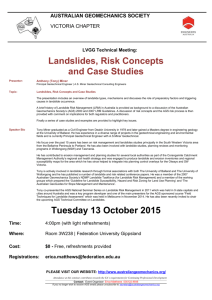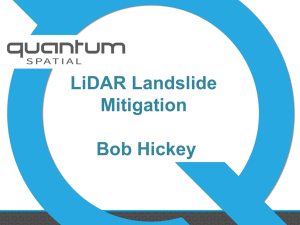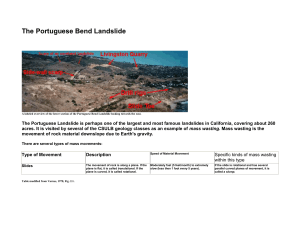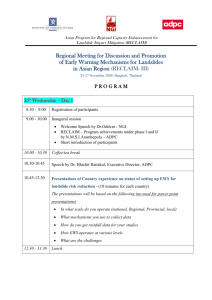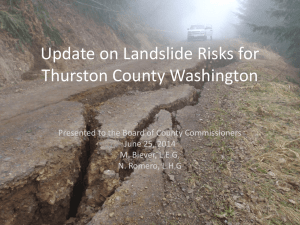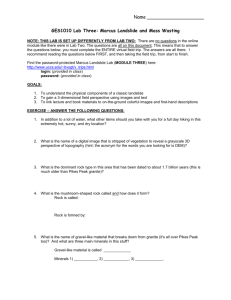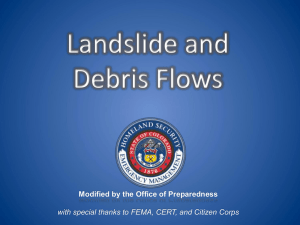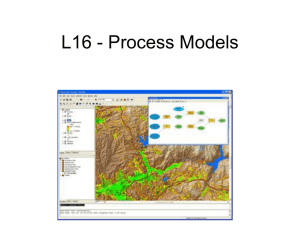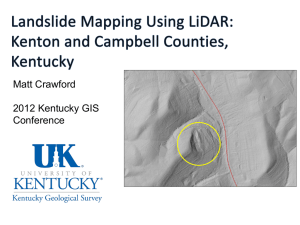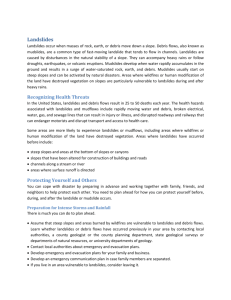GSA14-SiteEffects
advertisement
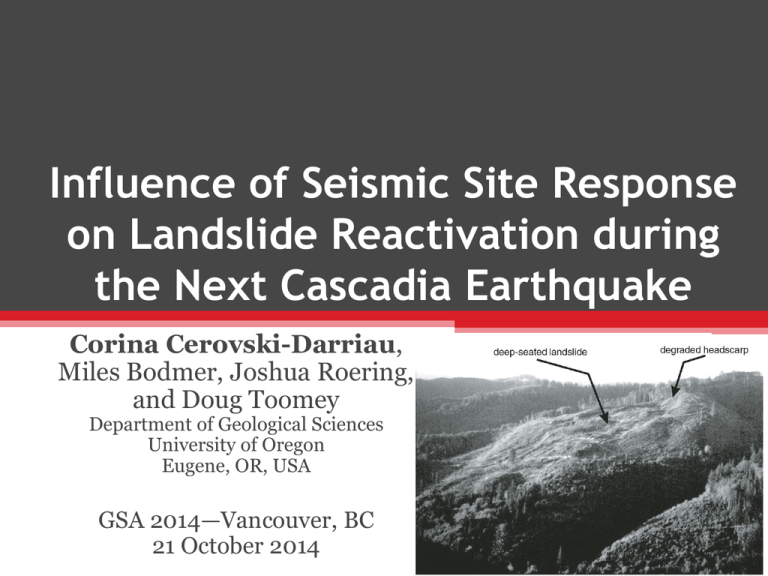
Influence of Seismic Site Response on Landslide Reactivation during the Next Cascadia Earthquake Corina Cerovski-Darriau, Miles Bodmer, Joshua Roering, and Doug Toomey Department of Geological Sciences University of Oregon Eugene, OR, USA GSA 2014—Vancouver, BC 21 October 2014 Coseismic Landslides and Cascadia • Earthquakes trigger landslides ▫ Often the more damaging hazard • M9 Cascadia earthquake occurs every 300-500 years ▫ And if so, what ground motion is needed for failure? Leonard et al., 2010 • Have Cascadia earthquakes triggered (or reactivated) landslides in the past? Motivating Question Will This Go to This in the Oregon Coast Range? 2010 landslide blocked highway in Taiwan for nearly 2 months Coseismic Landslides and Cascadia • Only need a single slide to reactivate to cause widespread damage • Landslides are significant primary and secondary hazard in Western Oregon ▫ Threaten lifelines, property and safety Rivers Highways Railroads 50m Runout 20m Runout Pipeline 0 500 1000 Number of Landslides Oregon Coast Range (OCR) • Predominantly Tyee Formation ▫ Middle Eocene turbidite sequence ▫ Subsequently uplifted and folded • Mean elevation: 450 m • Characterized by steep hillslopes and narrow debris-flow carved valleys Tyee Formation Large bedrock landslide, showing flat, bench-like morphology Roering et al., 2005 Typical OCR ridge-valley topography Coseismic Site Effects • Quantify shaking amplification within an existing landslide deposit ▫ Using horizontal-vertical spectral ratios (HVSR), and ideally, standard spectral ratios (SSR) ▫ Calculate ratios using both weak motion and ambient noise data • Compare amplification within landslide deposit to amplification at ridgetop ▫ Look for potential influence of topography vs. substrate Coseismic Site Effects Site Amplification Depends on: 1. Velocity contrast between substrate layers due to impedance 2. Thickness of landslide deposit 3. Topography 𝐴2 = 𝐴1 A=amplitude υ=wave velocity Bedrock Sediment Impedance 1. Wave amplitude changes with variations in velocity and density of substrate 2. Amplitude increases as wave moves into slower, looser material (i.e. from bedrock to landslide deposit) 𝜌1 𝑣1 𝜌2 𝑣2 Impedance Pilot Study—Site Location • Deep-seated paleolandslide ▫ 5-15 m deep ▫ 400 m wide and 600 m long • Approximately ~100 ky old N N 200 m 200 m NCALM Lidar (flown 2013) ▫ More recent reactivation Pilot Study—Site Location • Deep-seated paleolandslide ▫ 400 m wide and 600 m long ▫ 5-15 m deep • Approximately ~100 ky old N N 200 m 200 m NCALM Lidar (flown 2013) ▫ More recent reactivation Pilot Study—Set-up • Installed 5 short-period seismometers ▫ 2 off-landslide; 3 on-landslide ▫ Deployed for 2 months ▫ Monitoring both ambient noise and weak motion Pilot Study—Data Processing • Picked 5 earthquake events ▫ M 2.6-4.1 ▫ Span 1 month • Used 5-400s noise sections • Processed data from each station using: ▫ 1 Hz high-pass filter and a weighted average smoothing • Calculated HVSR for E-W and N-S component • Compared HVSR and peak frequencies Pilot Study—Results • From a single event: ▫ Shift in peak frequency on vs. off the landslide ▫ Largest amplitudes are at the ridgetop (Vaughn1) and in the middle of the landslide (Vaughn2) Pilot Study—Results • Stack of 5 events and ambient noise display similar trends: ▫ Shift in peak frequencies ▫ Largest amplitude for ridgetop and middle of the deposit Pilot Study—Verification • Peak frequency relates to landslide thickness 𝑓= 𝑉𝑠 4𝐻 • Verified results by comparing: 1. Seismic refraction survey 2. Borehole data 3. Spectral data • At Vaughn3, thickness predicted by peak frequency agrees with other methods 1. Refraction: 4-5 m 2. Borehole: 4.8 m 3. Frequency: 4-8 m (Vs=120-140 m/s and 𝑓=6-7 Hz) Vaughn3 Borehole Conclusions • Found 2-3x amplification within the landslide compared to the neighboring bedrock ▫ Found similar amplification at the ridgetop • Peak frequencies on the landslide are greater than the surrounding area ▫ Correspond to thicker and/or less consolidated deposits • Highly variable across the landslide ▫ Need a denser array ▫ Need a better reference station • Topography and substrate properties have similar influence on site response ▫ Seismic energy from a CSZ earthquake will be amplified within landslide deposits and at ridgetops


